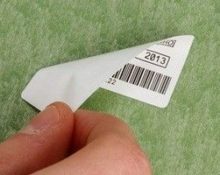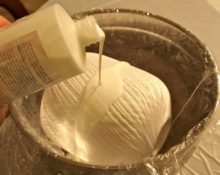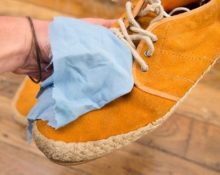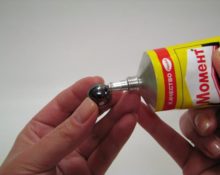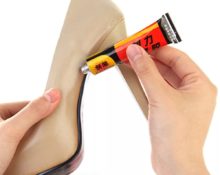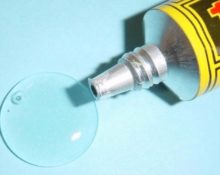Rhinestones often fall off, leaving unsightly marks on clothing. Restoring their numbers may be an impossible task, but it is possible to remove traces and get rid of slightly boring decorations. How to remove glue stains, what products and methods should be used, read on.
What glue is used to glue rhinestones?
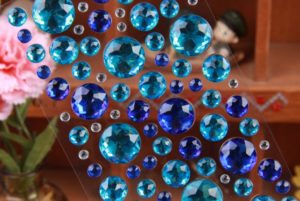 To attach glitter to the fabric of a dress, blouse or blouse, various adhesives are used in production. Completing the assigned task – dissolving and removing traces of rhinestone attachment - depends on how correctly we can determine the composition of the glue. Each type has its own methods for removing chemical residues from the material.
To attach glitter to the fabric of a dress, blouse or blouse, various adhesives are used in production. Completing the assigned task – dissolving and removing traces of rhinestone attachment - depends on how correctly we can determine the composition of the glue. Each type has its own methods for removing chemical residues from the material.
Rhinestones can be attached to fabric with different types of glue:
- thermoplastic. When heated, epoxy resin fills the entire interfiber space, and at negative temperatures it hardens;
- cold fix epoxy.With this method of application, the cooled composition also becomes hard, with strong cooling it becomes brittle, and when heated it melts;
- Water-based PVA. It is used only for the production of cheap clothes; it does not hold rhinestones well, but is perfectly soluble in water;
- silicone. It does not fill the interfiber space, retains glitter, remaining on the surface, and melts during heat treatment.
Ways to remove glue from rhinestones from clothes
If the composition is known, then you can easily determine the correct way to clean the fabric from traces. More often, there are cases when the method of attaching rhinestones is unclear, so the removal of glue is carried out experimentally after a visual examination of the stain remaining on the material.
Important! When choosing a method for removing glue, try appropriate methods on those areas of the fabric that are less noticeable.
Heat
This method can only be applied to compositions that will soften and melt at high temperatures. Algorithm of actions:
 on an ironing board or other horizontal surface, place a product with traces of rhinestones so that a layer of white paper covers it on top and bottom, and on the wrong side, lay a soft cotton cloth between the paper and the clothing;
on an ironing board or other horizontal surface, place a product with traces of rhinestones so that a layer of white paper covers it on top and bottom, and on the wrong side, lay a soft cotton cloth between the paper and the clothing;- start ironing the material over the paper from the face, gradually increasing the temperature to the allowed maximum value;
- the glue should melt and be absorbed into the cotton pad;
- Use a sponge, eraser or cloth to remove residue.
Important! Using the same principle, you can work with a soldering iron in compliance with safety precautions. When the glue softens, it is removed, carefully prying it off with a sharp blade. You need to work very quickly - the glue may cool down.
To freeze
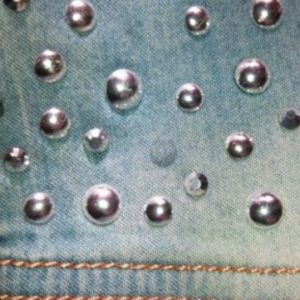 Deep freezing can destroy the structure of most compositions applied in a molten state. PVA and casein are easily removed if the residues on the fabric are soaked in water before placing them in the freezer. As a result of exposure to low temperatures, the glue is easily removed from the material, leaving it intact.
Deep freezing can destroy the structure of most compositions applied in a molten state. PVA and casein are easily removed if the residues on the fabric are soaked in water before placing them in the freezer. As a result of exposure to low temperatures, the glue is easily removed from the material, leaving it intact.
The essence of the method is placing the product in the freezer for 6 hours or more. Pre-pack your clothes in a bag so that they do not get dirty or freeze to the walls. After this procedure, lightly tap the stain with a hammer, the glue should crumble into pieces. Now it is easy to remove from clothes. If fragments remain, then the work must be continued with a stiff brush.
Wash
This thermal method is applicable if you need to remove a composition that melts at high temperatures. The product is washed in a machine in the hottest water recommended for this type of fabric.. Place the clothes in the drum and run the wash cycle for 2 hours or more. At the end of the process, all or most of the glue should be removed.
Natural white fabrics are cleaned of rhinestones by washing in an automatic machine with detergent and soda. In this case, you also need to choose the longest program. Soda forms an alkaline environment, and glue marks will completely disappear.
Treat with solvent
Natural fabrics can be cleaned using any chemical solvents; only acids and liquids with chlorine are prohibited. The first will corrode any fabric, and chlorine will discolor it. A specific type of glue also uses its own solvent:
 silicone or acrylic compound will remove acetone.Soak the problem area in the solvent for a while, and then remove the remaining glue with napkins or a clean cloth;
silicone or acrylic compound will remove acetone.Soak the problem area in the solvent for a while, and then remove the remaining glue with napkins or a clean cloth;- epoxy resin is neutralized by turpentine. Applied from the outside and inside, it removes glue by wiping the stain with a napkin or tampons;
- gasoline, white spirit, and nail polish remover are used in a similar way;
- To get rid of a specific odor, whitish stains and greasy stains after working with solvents, rinse problem areas with medical alcohol, wash the product several times and air it.
Important! Before you begin cleaning the stain, test the solvent with the fabric on an inconspicuous interior area of the item.
And if the fabric is delicate, how to remove the glue?
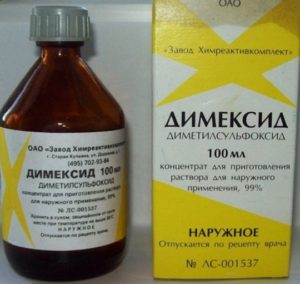 Turpentine, gasoline, and acetone cannot be used for many types of fabric. Delicate materials must be cleaned using a gentle freezing method or using another solvent - dimexide.. This is a medicine that is sold in any pharmacy, but it removes adhesive traces from any type of fabric, including thin, delicate ones.
Turpentine, gasoline, and acetone cannot be used for many types of fabric. Delicate materials must be cleaned using a gentle freezing method or using another solvent - dimexide.. This is a medicine that is sold in any pharmacy, but it removes adhesive traces from any type of fabric, including thin, delicate ones.
Dimexide is diluted with water for use.. The ratio must be selected depending on the type of fabric, but you should start with the most transparent solution, which will contain the maximum amount of water.
Security measures
To save your favorite thing without getting hurt, be sure to follow personal safety measures:
- carry out all work wearing special gloves;
- When cleaning with solvents, do not eat, drink or smoke;
- If the chemical accidentally gets into your eyes, rinse them thoroughly with running water and wash your hands with soap before doing so. In the event of a chemical burn, immediately seek professional help.;
- be sure to ventilate the room in which you work well;
- Small children and pets should be removed from the room during cleaning.


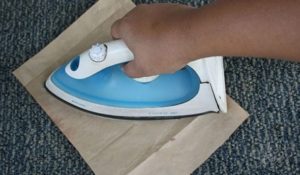 on an ironing board or other horizontal surface, place a product with traces of rhinestones so that a layer of white paper covers it on top and bottom, and on the wrong side, lay a soft cotton cloth between the paper and the clothing;
on an ironing board or other horizontal surface, place a product with traces of rhinestones so that a layer of white paper covers it on top and bottom, and on the wrong side, lay a soft cotton cloth between the paper and the clothing;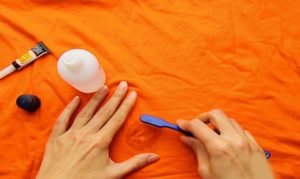 silicone or acrylic compound will remove acetone.Soak the problem area in the solvent for a while, and then remove the remaining glue with napkins or a clean cloth;
silicone or acrylic compound will remove acetone.Soak the problem area in the solvent for a while, and then remove the remaining glue with napkins or a clean cloth; 0
0